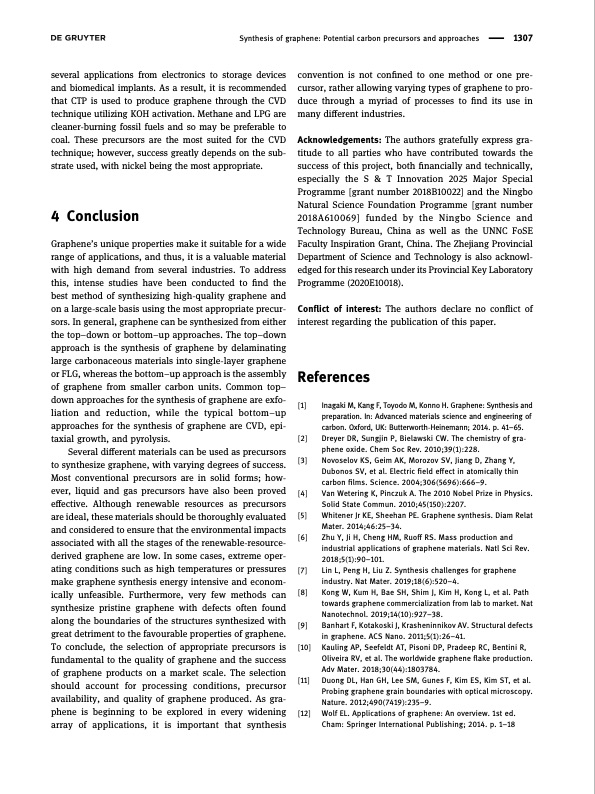PDF Publication Title:
Text from PDF Page: 024
Synthesis of graphene: Potential carbon precursors and approaches 1307 several applications from electronics to storage devices and biomedical implants. As a result, it is recommended that CTP is used to produce graphene through the CVD technique utilizing KOH activation. Methane and LPG are cleaner-burning fossil fuels and so may be preferable to coal. These precursors are the most suited for the CVD technique; however, success greatly depends on the sub- strate used, with nickel being the most appropriate. 4 Conclusion Graphene’s unique properties make it suitable for a wide range of applications, and thus, it is a valuable material with high demand from several industries. To address this, intense studies have been conducted to find the best method of synthesizing high-quality graphene and on a large-scale basis using the most appropriate precur- sors. In general, graphene can be synthesized from either the top–down or bottom–up approaches. The top–down approach is the synthesis of graphene by delaminating large carbonaceous materials into single-layer graphene or FLG, whereas the bottom–up approach is the assembly of graphene from smaller carbon units. Common top– down approaches for the synthesis of graphene are exfo- liation and reduction, while the typical bottom–up approaches for the synthesis of graphene are CVD, epi- taxial growth, and pyrolysis. Several different materials can be used as precursors to synthesize graphene, with varying degrees of success. Most conventional precursors are in solid forms; how- ever, liquid and gas precursors have also been proved effective. Although renewable resources as precursors are ideal, these materials should be thoroughly evaluated and considered to ensure that the environmental impacts associated with all the stages of the renewable-resource- derived graphene are low. In some cases, extreme oper- ating conditions such as high temperatures or pressures make graphene synthesis energy intensive and econom- ically unfeasible. Furthermore, very few methods can synthesize pristine graphene with defects often found along the boundaries of the structures synthesized with great detriment to the favourable properties of graphene. To conclude, the selection of appropriate precursors is fundamental to the quality of graphene and the success of graphene products on a market scale. The selection should account for processing conditions, precursor availability, and quality of graphene produced. As gra- phene is beginning to be explored in every widening array of applications, it is important that synthesis convention is not confined to one method or one pre- cursor, rather allowing varying types of graphene to pro- duce through a myriad of processes to find its use in many different industries. Acknowledgements: The authors gratefully express gra- titude to all parties who have contributed towards the success of this project, both financially and technically, especially the S & T Innovation 2025 Major Special Programme [grant number 2018B10022] and the Ningbo Natural Science Foundation Programme [grant number 2018A610069] funded by the Ningbo Science and Technology Bureau, China as well as the UNNC FoSE Faculty Inspiration Grant, China. The Zhejiang Provincial Department of Science and Technology is also acknowl- edged for this research under its Provincial Key Laboratory Programme (2020E10018). Conflict of interest: The authors declare no conflict of interest regarding the publication of this paper. References [1] Inagaki M, Kang F, Toyodo M, Konno H. Graphene: Synthesis and preparation. In: Advanced materials science and engineering of carbon. Oxford, UK: Butterworth-Heinemann; 2014. p. 41–65. [2] Dreyer DR, Sungjin P, Bielawski CW. The chemistry of gra- phene oxide. Chem Soc Rev. 2010;39(1):228. [3] Novoselov KS, Geim AK, Morozov SV, Jiang D, Zhang Y, Dubonos SV, et al. Electric field effect in atomically thin carbon films. Science. 2004;306(5696):666–9. [4] Van Wetering K, Pinczuk A. The 2010 Nobel Prize in Physics. Solid State Commun. 2010;45(150):2207. [5] Whitener Jr KE, Sheehan PE. Graphene synthesis. Diam Relat Mater. 2014;46:25–34. [6] Zhu Y, Ji H, Cheng HM, Ruoff RS. Mass production and industrial applications of graphene materials. Natl Sci Rev. 2018;5(1):90–101. [7] Lin L, Peng H, Liu Z. Synthesis challenges for graphene industry. Nat Mater. 2019;18(6):520–4. [8] Kong W, Kum H, Bae SH, Shim J, Kim H, Kong L, et al. Path towards graphene commercialization from lab to market. Nat Nanotechnol. 2019;14(10):927–38. [9] Banhart F, Kotakoski J, Krasheninnikov AV. Structural defects in graphene. ACS Nano. 2011;5(1):26–41. [10] Kauling AP, Seefeldt AT, Pisoni DP, Pradeep RC, Bentini R, Oliveira RV, et al. The worldwide graphene flake production. Adv Mater. 2018;30(44):1803784. [11] Duong DL, Han GH, Lee SM, Gunes F, Kim ES, Kim ST, et al. Probing graphene grain boundaries with optical microscopy. Nature. 2012;490(7419):235–9. [12] Wolf EL. Applications of graphene: An overview. 1st ed. Cham: Springer International Publishing; 2014. p. 1–18PDF Image | Synthesis of graphene Potential carbon precursors

PDF Search Title:
Synthesis of graphene Potential carbon precursorsOriginal File Name Searched:
10-1515-ntrev-2020-0100.pdfDIY PDF Search: Google It | Yahoo | Bing
Salgenx Redox Flow Battery Technology: Power up your energy storage game with Salgenx Salt Water Battery. With its advanced technology, the flow battery provides reliable, scalable, and sustainable energy storage for utility-scale projects. Upgrade to a Salgenx flow battery today and take control of your energy future.
CONTACT TEL: 608-238-6001 Email: greg@infinityturbine.com (Standard Web Page)